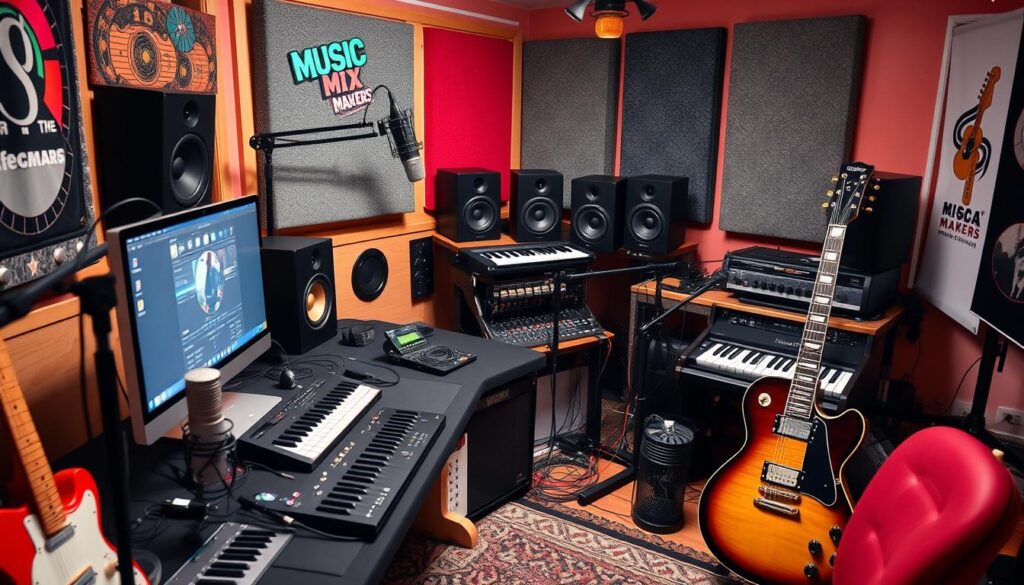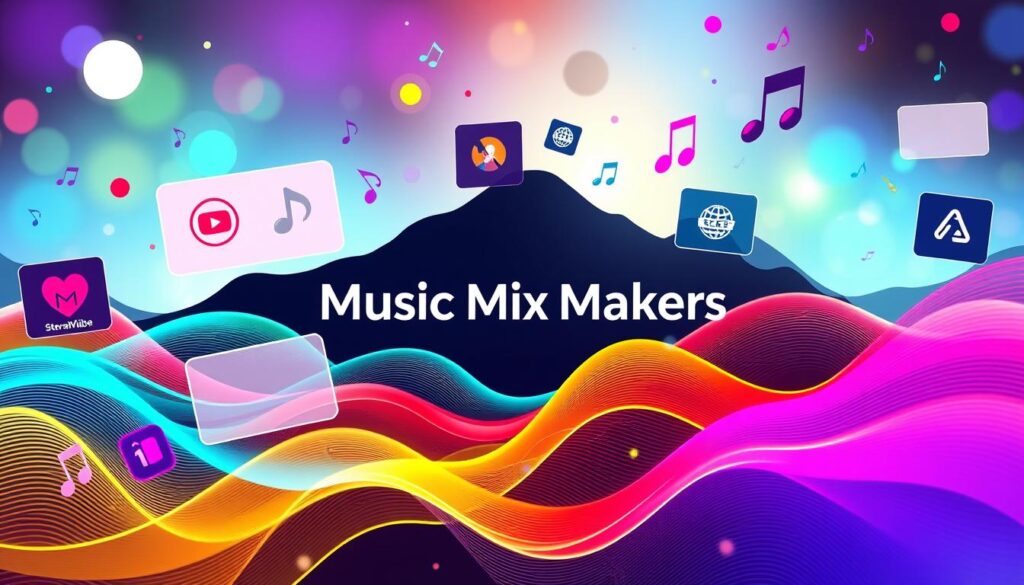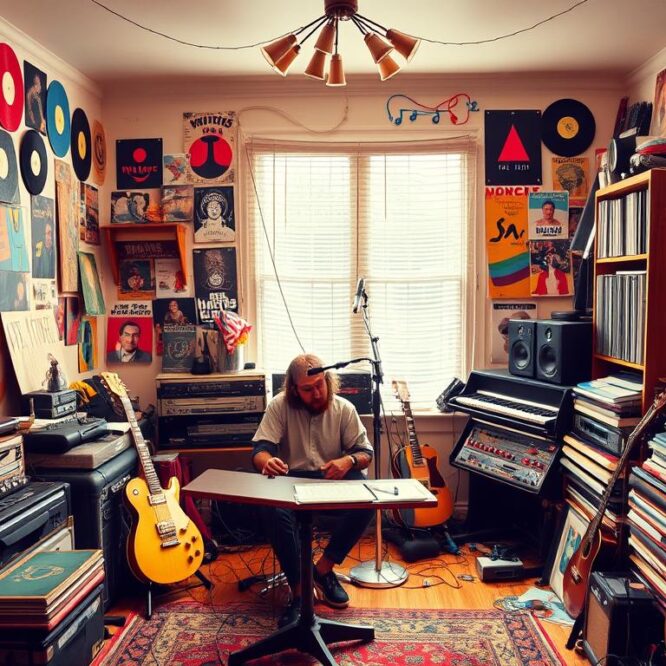In today’s rapidly evolving music industry, the rise of independent artists has become a driving force, reshaping the way music is created, distributed, and consumed. As an independent musician, the opportunity to release your music without the constraints of traditional record labels is both empowering and exciting. By understanding the nuances of independent music release, you can harness the full potential of your creativity and connect with a global audience.
Key Takeaways
- Independent music release offers artists greater control and flexibility over their careers.
- Advancements in technology have made it easier for musicians to self-release and promote their music.
- Successful independent music release requires a strategic approach to recording, distribution, and marketing.
- Building a strong online presence and engaging with fans are crucial elements of independent music promotion.
- Leveraging the right distribution platforms can maximize the reach and sales of your music.
Understanding the Landscape of Independent Music Release
The independent artist movement has been steadily gaining momentum in recent years, driven by the increasing accessibility of digital platforms and advancements in music technology. This shift has empowered musicians to bypass traditional record labels and release their music directly to their audience, opening up a world of independent artist success and DIY music career opportunities.
Rise of Independent Artists
The rise of independent artists can be attributed to several key factors. The democratization of music distribution and promotion through online platforms has allowed musicians to reach global audiences without the need for a major label’s infrastructure. Additionally, the availability of affordable, high-quality recording equipment and digital audio workstations has made it easier for artists to produce and refine their own recordings, further fueling the independent artist movement.
Benefits of Independent Music Release
The benefits of independent music release are numerous. Artists who choose to self-release their music often enjoy greater creative control and a higher potential for artistic fulfillment. They can also establish a direct connection with their fans, fostering a sense of community and loyalty. Moreover, independent artists often retain a larger share of the revenue generated from their music, allowing them to reinvest in their careers and artistic development, contributing to the overall benefits of self-releasing music.
“The independent artist movement has revolutionized the music industry, empowering musicians to take charge of their careers and connect with their audience in unprecedented ways.”
As the music industry trends continue to evolve, the opportunities for independent artists to thrive have never been greater. The rise of this movement has not only provided musicians with greater creative freedom but has also transformed the way music is consumed and appreciated by audiences worldwide.
Professional Recording: Capturing Your Sound
As an independent artist, the quality of your recordings is paramount. Professional music recording studios offer unparalleled advantages in capturing your sound with precision and clarity. By investing in professional recording sessions, you can elevate your music to new heights, ensuring every note, beat, and vocal inflection is reproduced with the utmost fidelity.
Importance of Quality Recordings
High-quality audio production is essential for making a lasting impression on your audience. Professional studios are equipped with state-of-the-art equipment and experienced sound engineers who can bring out the best in your music. The right recording environment can make a significant difference in the overall sound and perception of your final product, which in turn affects how your music is received by your listeners.
Working with Professional Studios
- Access to top-notch recording gear and acoustic spaces
- Collaboration with skilled sound engineers and producers
- Ability to capture the true essence of your performance
- Attention to detail and creative input throughout the process
- Efficient workflow and streamlined post-production
While investing in professional recording sessions may require a financial commitment, it is a worthwhile investment for artists seeking to establish a strong presence in the music industry. The benefits of working with a professional studio can elevate your music to new heights and help you connect with your audience on a deeper level.
“The right studio can make a significant difference in the sound of your final product, which in turn affects how your music is received by your audience.”
Mixing and Mastering: Refining Your Masterpiece
Creating captivating music is more than just recording great-sounding tracks. The true magic happens in the post-production process of music mixing and mastering. These crucial steps are essential for achieving the professional sound quality you desire and refining your recorded tracks to perfection.
Mixing is the process of blending and balancing individual elements of your recording, such as vocals, instruments, and effects. It involves adjusting levels, panning, and applying time-based audio effects like reverb, delay, and chorus to craft a cohesive and polished mix. The goal is to create a well-balanced, three-dimensional soundscape that showcases each element in its best light.
Mastering, on the other hand, is the final step in the post-production process. It’s the art of enhancing and refining the overall sound quality of your mix, ensuring consistency across all tracks and preparing the recording for distribution. Mastering engineers use specialized equipment and techniques to improve the clarity, punch, and warmth of your music, making it ready for the world to hear.
While you can certainly attempt mixing and mastering on your own, working with professional audio engineers who have the expertise and specialized equipment can make a significant difference in the quality of your final product. Their trained ears and extensive experience can help you achieve the professional sound quality that will make your music shine.
“Mixing and mastering are the difference between a good recording and a great one. It’s where the magic really happens.”
Investing in professional music mixing and mastering services is often one of the best decisions an independent artist can make. It’s the final step in refining your recorded tracks and ensuring your music is ready to captivate listeners.
DIY Recording: A Cost-Effective Alternative
For many independent artists, professional studio time may not always be accessible or affordable. However, with the right knowledge and tools, you can achieve great results from DIY music recording. Unleash your creativity and take control of your sound by exploring the world of DIY recording techniques.
Tips for Successful DIY Recording
Crafting high-quality DIY recordings requires a strategic approach. Here are some valuable tips to help you master the art of DIY music recording:
- Choose the right environment: Select a quiet, acoustically treated space to minimize unwanted noise and echoes.
- Invest in quality equipment: Prioritize purchasing a reliable microphone, audio interface, and headphones to capture your sound with clarity.
- Learn basic recording techniques: Familiarize yourself with microphone placement, signal routing, and fundamental mixing concepts.
- Use professional-grade recording software: Leverage user-friendly, affordable software like GarageBand or Audacity to bring your DIY recordings to life.
- Experiment with sound: Don’t be afraid to try different techniques, effects, and arrangements to find your unique sonic signature.
- Regularly back up your recordings: Protect your hard work by implementing a reliable backup strategy.
- Seek feedback from trusted sources: Share your DIY recordings with fellow musicians or audio enthusiasts to gain valuable insights and perspectives.
With patience and dedication, DIY recording can be a deeply rewarding process, allowing you to develop essential skills and maintain control over your creative vision. While it may require more time and effort, the journey of crafting your own high-quality self-recordings can be a fulfilling and empowering experience as an independent artist.

“The beauty of DIY recording is that you can experiment endlessly, refining your sound until it’s exactly how you want it.”
How to Release Music Independently
Releasing music independently involves a multifaceted approach that requires careful planning and execution. As an independent artist, you have the power to take control of your music distribution and reach your audience directly. Let’s explore the essential steps to successfully self-release your music and build your independent music career.
Selecting the Right Distribution Platforms
The first step in your independent music release strategy is to research and choose the right distribution platforms. These platforms, such as Spotify, Apple Music, and Bandcamp, will be the gateway for your music to reach listeners worldwide. Evaluate the strengths and limitations of each platform to ensure your music is accessible to your target audience.
Establishing an Online Presence
A strong online presence is crucial for independent artists. Create a professional website that showcases your music, brand, and personality. Maintain active social media profiles on platforms like Instagram, Twitter, and Facebook to connect with your fans and build your following. Consistent branding and engagement will help you stand out in the crowded music landscape.
Building Your Artist Identity
Developing a unique and compelling artist identity can significantly impact your independent music release strategy. Invest time in defining your persona, creating visually striking album artwork, and ensuring that your overall brand reflects your musical style and personality. A cohesive artist identity will help you capture the attention of potential listeners and solidify your place in the industry.
Maximizing Online Music Sales
To optimize your independent music sales, leverage the features and tools offered by various distribution platforms. Utilize platform-specific promotions, playlisting opportunities, and targeted advertising to increase the visibility and accessibility of your music. Additionally, engage with your fans through interactive content, exclusive offers, and personalized experiences to foster a loyal following and drive ongoing music sales.
By following these steps, you can navigate the independent music release landscape and successfully self-release your music. Remember, independent music distribution and building an artist identity are ongoing processes, so be prepared to continuously adapt and refine your strategies as you grow your independent music career.
Building Your Artist Identity
As an independent musician, developing a strong and distinctive artist identity is crucial to standing out in the crowded music industry. Your artist identity encompasses far more than just a name or logo; it’s the essence of who you are as an artist, reflecting your musical style, influences, and the message you want to convey through your music.
Defining Your Persona
Creating a unique musical persona is an essential step in building your independent artist brand. This persona should resonate with your target audience and set you apart from other artists in your genre. Consider the following when crafting your persona:
- Your musical style, influences, and the emotions you want to evoke in your listeners
- Your personal story and the unique experiences that have shaped your artistry
- The visual elements, such as your stage presence and fashion choices, that will support your persona
Importance of Visuals and Album Artwork
In the world of independent music, visuals and album artwork play a vital role in how your music is perceived. Your album cover is often the first point of interaction for potential listeners, and it should effectively communicate the essence of your musical persona. Invest time and resources into developing a compelling visual brand that complements your music and resonates with your target audience.
“Your album artwork is a visual representation of your music. It should capture the mood, emotion, and style of your songs, drawing listeners in and making them eager to discover more.”
Consistent and visually striking branding across all your platforms, from your social media to your live performances, will help cement your identity as an independent artist and create a lasting impression on your fans.
Establishing an Online Presence
In today’s digital landscape, having a strong online presence is crucial for independent artists like yourself. Your online platforms serve as a hub where fans can discover your music, learn more about your artistic journey, and stay connected with your latest releases and events. Building an online presence for musicians is a strategic step in your journey to release music independently.
Essential Online Platforms
To establish a robust online presence, focus on leveraging the following essential social media platforms for artists:
- A professional website that showcases your music, biography, and upcoming shows
- Active social media profiles on platforms like Instagram, Twitter, and Facebook to engage with your audience
- Presence on music streaming services like Spotify, Apple Music, and YouTube to make your music widely accessible
Maintaining Brand Consistency
Consistency is key when it comes to maintaining a cohesive brand image as an independent artist. Ensure that your visual identity, messaging, and overall tone are uniform across all your online channels. This helps to build a strong and recognizable brand that resonates with your fans.
Regularly update your content, interact with your audience, and share behind-the-scenes glimpses of your creative process. This not only keeps your fans engaged but also helps to establish you as a relatable and authentic artist. Leveraging digital marketing strategies for independent artists can further amplify your online presence and reach new listeners.
By establishing a captivating online presence, you can effectively showcase your talent, connect with your audience, and ultimately, increase your chances of successfully releasing music independently.
Selecting the Right Distribution Platforms
In the digital age, choosing the right platforms for music distribution is crucial for independent artists. Each platform offers a unique audience, features, and benefits. Understanding the strengths and limitations of various platforms can help you make informed decisions about where your music will have the greatest impact and reach.
Understanding Different Platforms
Popular streaming services like Spotify and Apple Music boast vast user bases and playlisting opportunities, while platforms like Bandcamp provide more control over pricing and a direct connection to your listeners. Researching the nuances of these independent music distribution platforms is key to aligning your music with the right audience.
Aligning with Your Genre’s Audience
Different platforms cater to different genres and audiences. By understanding the preferences and habits of your target listeners, you can strategically place your music where it will be discovered and appreciated. Leveraging the unique features and communities of various distribution channels can help you connect with the right fans and grow your fanbase.
The goal is not just to have your music available online but to position it where it will resonate most with your audience. Careful consideration of the independent music distribution platforms and their alignment with your genre’s audience can make all the difference in your independent music release journey.

“The right distribution platform can be the key to unlocking your music’s full potential and connecting with your target audience.”
Maximizing Online Music Sales
As an independent artist, maximizing your online music sales is crucial for building a sustainable career. To achieve this, it’s essential to leverage the unique features and capabilities of various streaming platforms and engage with your fans through strategic promotion.
Leveraging Platform-Specific Features
Each music streaming platform offers its own set of tools and features that can help you drive sales. For example, on Spotify, you can utilize the pre-save function to build anticipation and encourage your fans to save your upcoming release. Similarly, Bandcamp’s pay-what-you-want model allows fans to support your music at a price they feel is fair, potentially increasing overall sales.
Engaging with Fans and Promotion Strategies
Fostering a strong connection with your fans is key to driving online music sales. Regularly engaging with your audience through social media, email newsletters, and live streams can help you build loyalty and keep them excited about your music. Consider offering exclusive content or special editions of your releases, such as limited-edition merchandise bundles, which can further incentivize fans to make purchases.
Additionally, leveraging various music marketing tactics, such as targeted digital ads, collaborations with other artists or influencers, and strategic playlist placements, can help increase the visibility of your music and reach new potential listeners who may become paying customers.
| Platform-Specific Features | Fan Engagement Strategies |
|---|---|
|
|
By understanding and leveraging the various tools and strategies available on each platform, independent artists can increase their visibility, grow their fanbase, and boost their sales in the world of digital music distribution.
Conclusion
The rise of independent artists has transformed the music industry, empowering musicians to take control of their careers and reach listeners directly. By understanding the nuances of how to release music independently, I can harness the power of digital platforms, professional recording techniques, and strategic marketing to build a successful DIY music career.
From capturing high-quality recordings to establishing a strong online presence and aligning with the right distribution channels, the steps outlined in this guide provide a solid foundation for independent artists to thrive in the ever-evolving music landscape. As the industry continues to evolve, the potential for independent musicians to find success and creative fulfillment has never been greater.
Whether it’s leveraging platform-specific features, engaging with fans, or implementing effective promotion strategies, this comprehensive guide has provided a summary of the key independent music release strategies. By applying these insights, I can effectively self-release my music and navigate the exciting future of the independent music scene.
